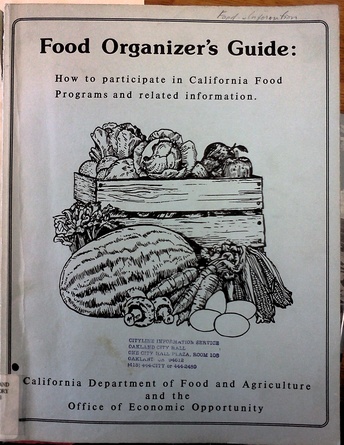 by mk30We used to have nice things.
by mk30We used to have nice things.
Food Organizer's Guide: How to participate in California's Food Programs and related information is a Feb. 1984 book prepared by the California Department of Food and Agriculture Direct Marketing Program in collaboration with the California Office of Economic Opportunity. Edited by Melissa Cadet, the publication was funded by the USDA FSMIP.
The book is a guide for nonprofits and communities to existing food distribution services and an instruction manual for participating in those programs and starting their own.
It includes detailed information (including addresses, eligibility, and contact info) on:
-
government programs that donate food for nonprofits that are providing direct services
- information provided includes elegibility requirements, how to enroll in the program, record-keeping & reporting requirements, how to order food, when to expect delivery, how the food arrives when it's delivered, the kind & size of storage & kitchen facilities that participating organizations should have to process donated food, and what the participating nonprofit is expected to do to fulfill its end of the partnership.
- addresses of government-run centers that provide direct food services like WIC
- addresses and contact info for non-government-run food banks
- contact info for government agencies at all levels of government that help connect people to food services.
- contact info for organizations that help groups who are starting programs with best practices, etc. (for example, in the section on starting your own senior citizen gleaning club, the book provides contact info for California-wide gleaning programs that provide assistance for those who want to start their own programs).
- detailed guide for starting your own food pantry including the key elements: the facility and paperwork, volunteers, food, and clients.
- detailed guide for starting your own farmers' markets.
- detailed guide for starting your own cooperative (not a joke), directory of co-ops, & list of publications that will assist those starting a co-op.
- detailed guide for starting a buying club/pre-order co-op.
Here are some of the wonderful-sounding things that existed in the alternate universe of 1984:
- USDA donations of surplus food for local organizations to distribute.
- Title VII of the Older Americans Act of 1965 provided funds for meals for older people. This is one of the acts that started the Meals on Wheels program which was apparently very well-run and liked by residents (according to reporting surveys) in Oakland.
- Brown Bag Network Program (administered by the Department of Aging) that provided funds for local organizations to set up programs to distribute weekly deliveries of bags of groceries.
- Senior citizen gleaning clubs where "thousands of elderly gleaners move[d] into the fields to gather large quantities of edible agricultural produce left behind in the harvesting process" and helped food banks and food pantries glean their food. The book recommends setting up arrangements with local farms to glean in a group once a week (sometimes with a membership fee) receive weekly bags of gleaned food. It also recommends setting up similar arrangements with local food banks.
- Food banks had teams of volunteer gleaners who would be able to spring into action whenever a farmer would call with an offer of excess crops.
-
Apparently there was a wonderful thing called the State Office of Economic Opportunity (SOEO) (created in 1966?) whose mission was "to stimulate an effective concentration of all available local, state, private and federal resources to enable low income families and individuals to obtain the skills, knowledge, and motivations to become self-sufficient. SOEO acts as a catalyst, as the "hub of the wheel", in leading the linkage of the Community Services Block Grant funds with other sources of funding and support to enhance the impact of locally determined programs." (p.67) In other words, we had a state office whose entire job was to help ensure that there was good coordination between all the moving pieces that were apparently working to create working livelihoods for California residents.
- Community organizations could sign up to be a member agency of the SOEO and become part of the food distribution network. They would be able to receive technical assistance and be a part of the entire "food chain" of assistance.
-
Community Action Agencies (CAAs) were local agencies designated by a county board of supervisors or a city counil to operate and coordinate anti-poverty programs. These were coordinated at the state level.
- Apparently these still exist, but Oakland doesn't have one (Berkeley does).
- Job Training Partnership Act (JTPA) (passed 1982, repealed 1998): Provided paid workers to community organizations at little or no cost, provided training for running food distribution organizations.
-
Farm Trail: organizations made up of farmers in a geographic area who publish a map indicating local farms that sell directly to individuals and community organizations at farm or roadside stands.
- There is still a farm trail directory, but it is published by the University of California and is apparently considered "agricultural tourism."
-
Rent-a-Tree: pay a farmer to reserve a tree that volunteers harvest.
- These still exist!
- California Farmer-to-Consumer Directory: Listed over 1,000 California farmers that sold directly to the public and lists of farmers' markets, farm trail organizations, community canneries, and more.
This wonderous book shows us how much they've taken away from us while also providing information that is extremely valuable for us today. It is available at the Oakland History Room in the Main Branch of the Oakland Public Library.



